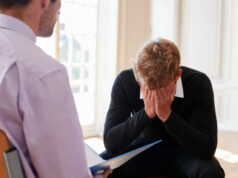Personality disorders are described as long-standing and lasting patterns of behavior. It is uncommon for them to be diagnosed during childhood or in adolescence primarily because at this age the individual is in development, is undergoing personality changes and is maturing.
That is why Adult Antisocial Behavior (AAB) (DSM-5)* is most often diagnosed in people when they are adults.
The disorder is 70 percent more common in males than females. AAB usually lessens in intensity with age, and many people experience fewer of its symptoms by the time they’re about 40 or 50 years old.
Many individuals with AAB don’t find treatment, as is generally common with people with personality disorders.
However, when the disorder begins to interrupt and debilitate the individual’s life, and they are unable to cope with the stress or other events in their lives, they may find therapy.
What are the Causes of Adult Antisocial Behavior?
The personality is made up of an individual’s thoughts, behaviors and emotions, as well as the way they relate to others. Asides the above, the personality is also determined by how a person views themselves.
It is formed during a person’s childhood and groomed by environmental factors as well as inherited traits.
While the specific cause of Adult anti-social behavior is unknown, the following are likely factors that contributes to its development.
- Genes may cause a person to be vulnerable to developing AAB, and some life situations may also be triggers for it.
- There possibly have been a few changes in a person’s brain functioning that occurred while the brain was still developing.
Several factors have been seen to increase a person’s chances of developing an AAB, and they include:
- Conduct disorder that may have been diagnosed in childhood.
- A history of antisocial personality disorder, OCD, other mental illnesses or personality disorders in the family.
- Abuse or neglect in childhood.
- Violent and unpredictable family life as a kid.
What are the most obvious symptoms of Adult Antisocial Behavior?
- Failure to respect or conform to social norms regarding acceptable or lawful behaviors and deliberately repeating acts (like the ones mentioned at the start of this article) that are grounds for arrest.
- Lying constantly, using aliases or conning other individuals for personal interests or pleasure.
- Aggressiveness and irritability as shown by repeated physical fights or assaults.
- Consistently proving to be irresponsible as shown by deliberately failing to keep a job time and again.
- A lack of remorse is obvious by showing indifference or by rationalizing his reasons for hurting, mistreating or stealing from another person.
- Evidence of Conduct Disorder as a child.
- Continually lying or deceiving others.
- Disregard for right and wrong.
- Scorn and disrespect toward others.
- Insensitivity and cruelty toward others.
- Using humor or appeal to manipulate other individuals in order to obtain personal gains or pleasure.
- Being excessively opinionated.
- Being mostly conceited and feeling superior or better than others.
- Always disregarding other people’s rights by bullying.
- Being careless and hasty; usually not planning beforehand.
- Being antagonistic and agitated.
- Violent and aggressive.
- Little or no guilt in hurting other people.
- Dangerous or risky actions that are unnecessary with not a single thought about safety for himself or for other people.
- Relationships are abusive or poor.
- Does not think about the negative outcome of his behavior and does not show remorse or learn from the consequences.
- Continually exhibits irresponsibility and not meeting financial or work commitments.
People who have AAB usually manifest signs of conduct disorder before the age of 15. These signs are made up of continuous and severe behavior problems.
They include:
- Hostile behavior to animals and people.
- Deceit.
- Devastation of property.
- Crime, including burglary.
- Severely breaking the rules.
Due to the problems and behavior surrounding AAB, there are several negative consequences that other people or the person may be at risk for, including:
- May abuse or neglect his child or spouse.
- Alcohol or substance abuse.
- Greater chance for dealing with other disorders such as depression or anxiety.
- Being arrested and sent to jail.
- Joining and participating in gang activities.
- Low or no financial status.
- Homelessness.
- Death as a result of violence.
Methods of treating Adult Antisocial Behavior
Considered a lifelong disorder, ABB has some symptoms such as destructiveness and criminal behavior that may diminish.
However, what is not certain is if the reason that these behaviors go away or lessen ultimately is because of growing older or from more knowledge about what the consequences of their actions would be.
Individuals who have AAB may be promoted to seek help with the encouragement of their family members or people they are close to. One of the most common treatment methods is Cognitive Behavioral Therapy.
We hope that you found this article helpful. Please don’t hesitate to leave a comment below.














Many thanks, please send me the menstral cycle article published yesterday
You can use the search box